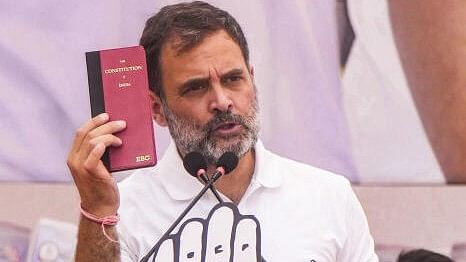
Congress leader and candidate from Rae Bareli constituency Rahul Gandhi holds a copy of the constitution of India while addressing a public meeting at Dilshad Garden for the Lok Sabha elections
Credit: PTI Photo
Lok Sabha 2024 was a battle between two competitive political blocs represented by opposite ideological articulations and political narratives.
This time, the presence of the Opposition alliance (I.N.D.I.A.) was felt against the incumbent Bharatiya Janata Party (BJP) government, unlike in the 2019 general elections. The Opposition experimented with a new language of politics, and played up the governance failures of the BJP, such as: inflation, the Agnipath scheme, farmers’ protest, examination paper leaks, unemployment, the Manipur unrest, the misuse of constitutional bodies, and the erosion of State institutions.
While BJP glued to its rhetoric of 400-plus and ‘Modi’s Guarantees’, the Opposition pushed issues — saving the Constitution, minority rights, and the representation of Scheduled Castes, Scheduled Tribes, and Backward classes. I.N.D.I.A. managed to create and drive the narrative in the 2024 campaign making the contest difficult for the BJP.
One singular theme — Save the Constitution, became the major political weapon used by the Opposition against the BJP. It has predominantly emerged as a reaction against the BJP’s ‘400-plus’ slogan, and the subsequent statement by Anant Kumar Hegde in March on replacing the Constitution by the BJP if it won. This was followed by alleged statements by Kirori Lal Meena in April and by others like Jyoti Mirdha, and Arun Govil. The Opposition, especially in North Indian states, cautioned the public against the BJP’s rhetoric of 400-plus seats and interpreted it as the saffron party’s intention to replace the Constitution and abolish the existing reservation system.
Primarily, the campaign for protecting the Constitution of India had its undercurrents in the CAA/NRC movement when Bhim Army Chief Chandrashekhar Azad, (who won from Nagina, Uttar Pradesh) was seen holding the Constitution up in the air at Jama Masjid, and became the agitation’s poster boy. Ever since then, the Constitution has increasingly become a symbol of resistance and a template against politics of hate and the BJP’s exclusion, as argued by the Opposition. Prime Minister Narendra Modi, in his campaign, tried to stem the ebb by retorting that the Constitution will not be disturbed and at a rally in West Bengal said that the Congress would snatch away the reservation from SC/STs and give it to Muslims. There is no doubt that the Constitution became a major point of contention.
The election results show that I.N.D.I.A. could significantly convert its campaign around saving the Constitution into votes and seats, especially in Uttar Pradesh and Rajasthan. It also seems that it has worked well in securing massive support from the Dalits and minorities, who are historically dependent upon the Constitution as a guarantee of their rights.
The larger-than-life image of Modi is also dented this time by the Opposition’s campaign and the faith of those who benefit from reservations eroded. The BJP’s political advertisement of development, good governance, anti-corruption, anti-dynasty politics, India’s image as Viswaguru, the saviour image of Hindus, and anti-Muslim stances failed to subdue the campaign for saving the Constitution as evident in its inability to cross the halfway mark in the Lok Sabha.
The ‘Save the Constitution’ campaign managed to form a strong public opinion against the BJP, and created an impression that the Constitution is the only solace for the public when the State fails to ensure its citizens’ rights. Poll results reflect that any tinkering with the Constitution by the regime will see spontaneous movements, both political and social, to save it, as the grounding of the ‘Save the Constitution’ has gone deep into the public imagination.
(Rehnamol Raveendran is Assistant Professor, Department of Political Science, University of Allahabad.)
Disclaimer: The views expressed above are the author's own. They do not necessarily reflect the views of DH.